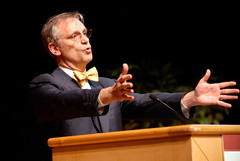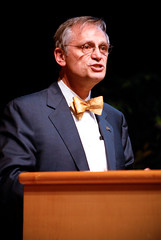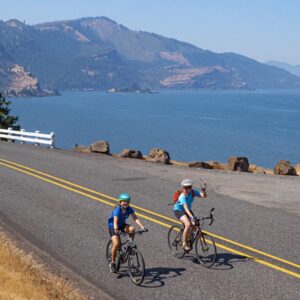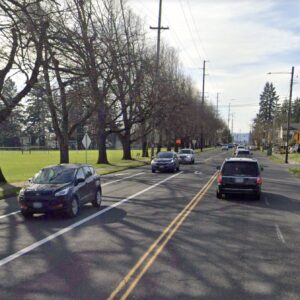This story is part of my ongoing coverage of the 2008 National Bike Summit. See the rest of my coverage here.
Congressman Earl Blumenauer offered a historical perspective in his speech to the 500+ National Bike Summit attendees this morning. Referring back to major U.S. transportation planning milestones in 1808 and 1908, he continued his call for a new national transportation plan.
He said our current transportation system is in dire straits in part because we lack a “sense of national purpose” and he said, “Isn’t it time for a vision of what we need for this century?”
Blumenauer reminded the audience how the U.S. used to be afraid of China’s weapons stockpiles but now, he said they have a real and potent advantage — their transportation infrastructure. He said China invests 8% of their yearly budget to the maintenance and upkeep of their transportation infrastructure versus a paltry 1% spent by the U.S.
“I think you out to be indignant about the fact that you’re not getting your fair share!”
–Rep. Blumenauer
Blumenauer was animated in his speech and seemed intent on lighting a fire of urgency and outrage coupled with a sense of opportunity for the future among the assembled crowd of bike advocates.
“I think you out to be indignant about the fact that you’re not getting your fair share!” he said, referring to how bicyclists still don’t get the same tax benefit motorists do for riding to work. He also addressed his displeasure with certain Republicans who are playing politics with bike issues.
Blumenauer specifically addressed comments made by House Republican Patrick McHenry back in August. McHenry (who Blumenauer referred to as a “marginal back-bencher”) infamously referred to bikes as, “promoting 19th century solutions to 21st century problems.” To this, and to a string of recent anti-bike comments from Republicans, Blumenauer said we should “be outraged” and he forcefully implored us to, “Stop partisan use of your issue now by going to the Republicans and asking them what the hell is going on!”
Then, stepping back from the podium, he put his hands together and said with a mockingly empathetic tone, “You need to help these people.”
In closing he made yet another reference to a national movement when he said, “We need to get those millions of bikes that are currently gathering dust in garages and basements and get them back on the roads.”
After his speech, Blumenauer met with David Jones, the CEO of Louisville, Kentucky-based Humana, Inc.. Humana is a major health care provider with 9,000 employees that has started a bike-sharing program called “Freewheelin'” that allows employees to use bikes around town for free (Jones also delivered a keynote speech at dinner last night).









Thanks for reading.
BikePortland has served this community with independent community journalism since 2005. We rely on subscriptions from readers like you to survive. Your financial support is vital in keeping this valuable resource alive and well.
Please subscribe today to strengthen and expand our work.
“We need to get those millions of bikes that are currently gathering dust in garages and basements and get them back on the roads.”
Yes! Straight out of our project we\’re getting ready to launch!
MC, enlighten us.
I couldn\’t make Lucky Lab last night…
I really want to, but I\’m leaving it to our hard working reporter/editor, Mr. Maus to have the first story on it- J will do a thorough and rounded article about it in the very near future. We\’ll launch it first on bikeportland, then send out releases to the national media.(that should give you a hint about the scope/size of this thing)
I\’m not trying to be coy – I just want it to be a full launch rather than posting a ramble that leaves stuff out and , it should be done by a reporter, not just put out there by me… or a position paper on the project. But you can email me off blog and I\’ll fill you in on it from the lucky lab meeting last night. mtcowboy@teleport.com It was a very lively and productive meeting on a bunch of exciting stuff including citations, ghost pedestrians, bikes, local safety bills.. wait a sec, I\’m guessing maus is gonna do a piece of that meeting also…
But, as we learned this week, you have to be OUTRAGED and indignant in a really polite manner at all times.
But seriously, Earl is right: It is time to demand more – more money, more safety, and more rights on the road.
Sounds sweet, MC.
Looking forward to it.
(Doing the anticipatory Homer dance)
_DA
Outrage can be good, but I think we really need to get outraged about THE RIGHT THINGS.
Like the fact that 40¸000 Americans are dying senselessly on our roads every year.
This is not about \”bicyclists,\” or \”pedestrians,\” or any other specific \”interest group.\” This includes all people using the roads.
If we can do more to rectify this situation — or, rather, BLOODBATH (and make no mistake, these deaths are LARGELY PREVENTABLE and senseless: the DMV itself admonishes drivers that the vast majority of \”accidents\” are caused by driver inattention and error) — then we can immeasurably improve safety and quality of life in this country for EVERYONE.
The effects that this will have on improving cycling will also be immense. Students of the subject are in nearly unanimous accord that the single biggest impediment to greater cycling adoption is perception of danger. Improving road safety by insuring that there are CONSEQUENCES for careless and reckless driving — and not just for accident victims — will improve both the perception and reality of road safety.
We need a \”MADD style\” movement for road safety in America.
Rep. Blumenauer could do for such a movement what Sen. Frank Lautenberg did for MADD, by introducing bills in Congress tying federal highway dollars to state adoption of tough new mandatory penalties for careless and reckless driving. Some examples:
Minimum $10,000 / 1yr for serious roadway injury or fatality in which a suspended driver is implicated
Minimum $6,000 / 6mo for serious roadway injury or fatality in which motorist inattention is judged a factor (eg, eating, cellphoning, etc)
etc.
Earth to Earl: come in Earl!
\”He said China invests 8% of their yearly budget to the maintenance and upkeep of their transportation infrastructure versus a paltry 1% spent by the U.S.\” bikeportland editor J.Maus relating Blumenauer\’s claim
It might be interesting to know more about the specifics of that statistic; what types of transportation infrastructure the 8% is spent on, and how much money it represents, given that China, as far as I\’m aware, has been a mostly non-single car occupancy nation.
Blumenauer\’s got the right idea though, about rousing bike people to stand their ground for improvements to our country\’s bike infrastructure. This can only help counter some of the miserable auto dominated conditions in our communities.
I vote for a major rethink of the need for \”bicycling infrastructure.\”
What if a large part of the need for and impetus towards this \”bicycling infrastructure\” simply evaporated, due to vastly improved road safety conditions everywhere, brought about by tough new enforcement standards, in conjunction with rising fuel prices and fewer vehicle miles?
so let\’s get practical. The bike lanes on Hawthorne Blvd. are too narrow to carry the bicycle traffic currently using them. I think it\’s time to widen the bike lanes to 8+ feet on Hawthorne Blvd eastbound from SE Grand to SE 11th. The motorists don\’t need 3 lanes and the 4\’ bike lane is too narrow. who\’s with me?
BURR:
I\’m against. We cyclists already have all the infrastructure that we need. Our infrastructure is called the US road and highway system. It\’s all \”bike infrastructure,\” except for those stretches of interstate highway explicitly off limits to us.
If the bike lane is too narrow, you can take the lane to the left. Reference ORS section 814.420 subsection 3(a).
Now, if the problem is that you or anyone else doesn\’t feel \”safe\” asserting your right of way, then that is a separate issue. There, the answer is a combination of EDUCATION and ENFORCEMENT.
If you are getting harassed by motorists and feel intimidated, then they can be charged with MENACING (ORS 163.190).
If existing laws are inadequate, then we should be promoting tough new laws and enforcement, until the roads are safe for all to use, and FEEL SAFE, too.
I argue that the demand for bike lanes is created by the low expectations we currently set for motorists — we do not expect them to exercise a high degree of care, to yield when required, to drive politely and professionally, etc, etc. Under such conditions, no wonder people unprotected by thousands of pounds of metal do not want to risk taking to the roads!
Unfortunately, however, bike lanes do little to really alleviate these problems, while providing a false sense of security to those who use them.
Instead, we should adopt real and PROVEN solutions to these problems. We know that TOUGH ENFORCEMENT WORKS. MADD has proven this in the fight against drunk driving, with nearly 50% reduction in alcohol involved fatalities in 25 years of pushing for tough new enforcement, driven by federally mandated standards.
There is no reason that the same logic cannot apply to careless and reckless driving too.
Antonio, how do you think that all of the improvements you suggest are going to happen? They all cost money. Lots of it, but bike infrastructure probably costs far less than any of them.
I\’ve got a feeling that potential for improving safety conditions with todays road infrastructure is fairly limited; What would it take? More red light cameras? Total street redesign? (big money). Tough new enforcement? (big money).
As I see it, the motor vehicle is largely responsible for the problems western societies have today. They\’re why most U.S. communities that have been built in the last 60 some years require people to travel so far away from their homes to secure the basic sustenance for day to day life.
There will probably always be a certain number of single occupancy motor vehicles, but it seems as though this mode of travel will become increasingly unfeasible. At least in urban and suburban communities, if numbers of motor vehicles attempting to use those areas streets, continues to increase.
If this does happen, and motor vehicles lose their dominance over road and street infrastructure, it seems likely that there will be an increasing receptivity and support from the general public for new street and road infrastructure that routinely, by force of public demand, places far more emphasis on new, increasingly better designed bike infrastructure than exists today.
Bike infrastructure is like a life ring for the dying motor vehicle culture. As far as I\’m concerned, the more the better.
the pure vehicular cycling argument will never hold water in the current environment. the danger is in over-designing and over-spending on cyclist-specific infrastructure. somehow a happy medium needs to be reached, so that sufficient and appropriate infrastructure is provided along with sufficient and appropriate education and enforcement. right now neither engineering, education nor enforcement are
sufficient or appropriate.
Don\’t listen to me. Listen to the DMV. Read the \”motorist handbook\”:
\”Human Error
Human error is the single most common cause of traffic crashes. The
leading factors in crashes are:
• Excessive speed;
• Lack of concentration; and,
• Improper evasive action\”
OR Drivers Manual, 2007-2009 (p. 57)
The leading causes of accidents are not \”road engineering errors.\” Not \”freak weather conditions.\” Not \”acts of God.\” They are simply OPERATOR ERROR.
Granted, people are imperfect. However, if you GREATLY INCREASE the costs to them of making mistakes, they WILL make far fewer voluntary mistakes.
Furthermore, contrary to what you\’ve said, the COST of enforcement measures can in fact be made REVENUE NEUTRAL, unlike costs for new infrastructure, albeit they will fall highly unevenly on MOTORISTS THEMSELVES.
Finally, such measures are POLITICALLY FEASIBLE — far more feasible, in fact, than heroic new \”bike infrastructure\” proposals. Why?
Because, just as in MADD\’s case, the targets of such new enforcement measures have no public advocates to defend against such measures. There is no self identified lobby group for \”careless drivers.\” No one will voluntarily self-identify as a \”careless driver.\” The slogan \”zero tolerance for careless and reckless driving\” has no and will have no credible opposition from any quarter.
BURR:
My arguments on enforcement DON\’T DEPEND ON VEHICULAR CYCLING. I\’m an advocate of vehicular cycling, but that issue is COMPLETELY INDEPENDENT of proven safety benefits of tough enforcement measures.
The proven benefits of tough enforcement dwarf by orders of magnitude anything else out there. And when safety conditions are greatly improved people will FEEL safer, too. When people feel safer, more people will use the roads for multimodal purposes.
More people feeling safe enough to make multimodal use of the roads, and fewer speeding and unsafe motorists, will mean more people will feel safe to use all the lanes of the roads as needed. A modicum of safety education can also help here — but I think that the safety enforcement campaign MUST COME FIRST. Anything else is putting the cart before the horse.
Burr, I never said anything about \’pure vehicular cycling\’, and that\’s not what I was suggesting. I believe that better bike infrastructure is perhaps something similar to the street infrastructure we have today, but with a larger proportion of it devoted to the support and promotion of cycling as a essential urban life saving option to motor vehicle travel.
I think of those shots I\’ve seen of streets in China during commute hours, filled with bikes and think, \’why shouldn\’t some U.S. cities be a little more like China in that respect?\’.
I\’m not an engineer, so maybe I just don\’t know, but my feeling is that most street infrastructure design created in the last 50 years invites human error to be a major contributor to the danger motor vehicles represent to vulnerable user sharing that infrastructure with them. Human error is a given in daily life. Is there any disputing this?
Amongst people making some human error while operating their cars, in a given period of time, separate those that do so deliberately from those that do so unintentionally..accidentally in other words. If the majority of human error driver incidents are deliberate, I suppose this might be something that could be corrected with stronger enforcement, if communities could afford to hire the officers to do the enforcement, if money from greater penalty related fines could be extracted from the offenders to pay for the officers.
It seems to me that the greater percentage of human error in traffic incidents is unintentional, and a byproduct of antiquated street infrastructure design; inattentiveness, distraction, fatigue, poor visibility, toxicity of engine and fuel vapors, to name a few. Designing streets to move far greater numbers of people on bikes than street designs today are able, more fluidly, more efficiently, seems like a wise thing to do. Motor vehicles are choking the life out of communities; downtown, or for example, out in the burb where I live, the beav.
wsbob:
we can speculate endlessly about the precise mix of causes of collisions — how much does human error get exacerbated by the complexity of streetscapes, for example? By intersections with too much visual noise? Etc etc. But one thing is certain:
Motorists can control their velocity with great precision. Driving more slowly gives a driver more time to respond to unpredictable conditions, to take in and decipher complex streetscapes, to take evasive actions when necessary, etc etc.
Drivers understand this dependency on speed instinctively, but it is also driven home in all driver education materials.
Drivers coping with the threat of greatly toughened enforcement standards will first of all VOLUNTARILY SLOW DOWN.
Furthermore, this will simultaneously reduce both the number of collisions, AND THEIR SEVERITY. Accident severity is proportional to kinetic energy, which goes as the SQUARE of velocity. Thus, even small decrements in velocity will make a BIG difference in destructive potential.
These factors, taken together, convince me that tough enforcement can have huge effects on improving roadway safety.
again, why shouldn\’t the bike lanes on lower hawthorne blvd be widened to an entire lane width, if the demand exists? the current amount of bicycle traffic eastbound on lower hawthorne has succeeded in overwhelming the capacity of the existing narrow door-zone bike lane, and it should be widened, not eliminated.
Fine, with me…. . Hire more cops. Hand out more citations for traffic violations. Especially if that\’s the key thing lacking in making streets more safe for everyone, by all means, do it. If nothing else, attempting this will be a learning experience and a reality check for a lot of people.
Personally, I don\’t think doing this is going to make enough of a difference, or change the fact that most existing street infrastructure design is inherently susceptible to collisions resulting from unintentional human error.
I\’m sure street infrastructure is going to get more technologically managed and controlled, because ultimately(though there\’s always a caveat), this is one of the easier ways to eliminate human error.
As for motor vehicles themselves, there\’s one device I\’ve wanted them to be a equipped with for a long time: a speedometer governor. Have them set for 55 mph or 65 mph as states allow. End of highway speeding problem.
wsbob:
We may not need more cops or more traffic citations, so much as drastically more severe penalties for the citations that are already being given out. Certain offenses, such as willful inattentiveness, especially when it leads to serious injuries or fatalities, have to be singled out for special attention.
The power of example setting comes into play here. Just as in the case of drunk driving, when people hear horror stories of huge fines and jail time for such offenses that they themselves formerly committed without thinking twice, most will wise up and clean up their acts.
I can remember in the 70s and early 80s when casual drinking was \”no big deal.\” Not anymore. Who today doesn\’t have the words \”designated driver\” in their vocabularies? It is universal now. But formerly, before MADD got started? This was unheard of.
It is about cultural change. We know from the example MADD has given us that CHANGE IS POSSIBLE.
I\’m outraged that Earl has devoted so much time and energy to the bicycle lobby while the Sellwood Bridge is FALLING INTO THE RIVER.
The Sellwood Bridge carries more traffic than ANY TWO LANE BRIDGE in the entire state, yet we have no federal funds for a replacement?
Our entire Congressional Delegation are Democrats (sans Walden and Smith), and it would create some nice construction jobs for several years. But we got zilch. Nothing. Nada from D.C.
Big \”Alaska\” Ted Stevens got a $220 million earmark to serve 50 residents (\”Bridge to Nowhere\”), and Earl brought us the Eastbank Esplanade? May I have more bacon, please?
Bruce, get a life! Sellwood bridge is not Federally funded infrastructure, and the Good Congressman was speaking at the Bicycle Summit, not a bridge-building summit. Appropriate speaches for appropriate venues. And don\’t compare Earl Blumenauer to Ted Stevens, one is a true Gentleman, the other is under investigation for corruption along with members of his (crime?) family…
Opus